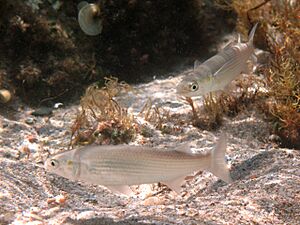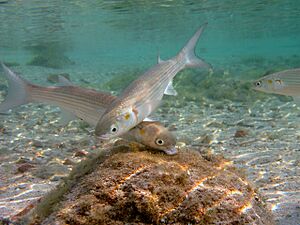Golden grey mullet facts for kids
Quick facts for kids Golden grey mullet |
|
|---|---|
 |
|
| Conservation status | |
| Scientific classification | |
| Synonyms | |
|
The golden grey mullet (Chelon auratus) is a cool fish. It belongs to the family of mullets, called Mugilidae. This fish is known for its sleek body and shiny scales.
Contents
About the Golden Grey Mullet
This fish has a smooth, long body. It's shaped like a cylinder, which helps it glide through water easily. Its strong tail fin helps it swim fast.
The golden grey mullet has a dark grey back. This color fades to a shiny silver-white on its belly. You can also see several grey stripes along its sides. A special golden spot is found near its gills. This is how it gets its name!
Size and Weight
Golden grey mullets can grow up to about 60 centimetres (24 in) long. They can weigh around 1.5 kilograms (3 lb 5 oz). But usually, you'll find smaller ones. Most golden grey mullets are about 30 centimetres (12 in) long.
Reproduction and Life Cycle
Golden grey mullets lay their eggs in the sea. This happens from July to November. This is when new baby mullets begin their life cycle.
Where Golden Grey Mullets Live
You can find golden grey mullets in many places. They live in the Eastern Atlantic Ocean, from Scotland down to Cape Verde. They are also common in the Mediterranean Sea and the Black Sea. You might see them along the coasts of southern Norway and Sweden. They are not found in the Baltic Sea.
They are rare off the coast of Mauritania. People have also brought them to live in the Caspian Sea.
Habitat and Diet
Golden grey mullets are a type of neritic species. This means they usually live close to the shore. They often swim into lagoons, ports, and river mouths. However, they rarely go into fresh water.
These fish like to eat small creatures that live on the seabed. They also eat tiny bits of dead plants and animals (detritus). Sometimes, they will eat insects or even tiny floating organisms called plankton.
Preferred Depths and Protection
They live in shallow waters, usually from 1 metre (0 ft) to 10 metres (30 ft) deep. Sometimes, they go deeper, up to 20 metres (70 ft). They prefer sandy bottoms. These areas often have plants and small rocks. This helps them find food and hide from bigger fish.
Larger fish like eels, European sea bass, and common dentex are their predators.
Fishing for Golden Grey Mullets
Many countries have rules about catching golden grey mullets. For example, the fish must be at least 20 centimetres (7.9 in) long to be kept. In some areas, these mullets are a main target for both commercial fishing and people fishing for fun.
Commercial Fishing
Fishermen catch them using special nets. These nets are designed to catch mullets that try to jump over the first net line. In Croatian waters, about 50 tonnes (49 long tons; 55 short tons) of golden grey mullets are caught each year.
Sport and Recreational Fishing
People who fish for fun often catch them with a rod and reel. They use fishing lines with floats and hooks. Popular baits include a paste made from flour, cheese, and fish guts. Sometimes, they will also bite on bread or plain cheese.
Cooking Golden Grey Mullets
The meat of the golden grey mullet is white, soft, and very tender. How it tastes can depend on where it was caught.
Smaller mullets are often pan-fried. If you barbecue them with olive oil, lemon juice, and parsley, they are often thought to be a special treat! You can also add golden grey mullet to a mixed fish stew.



